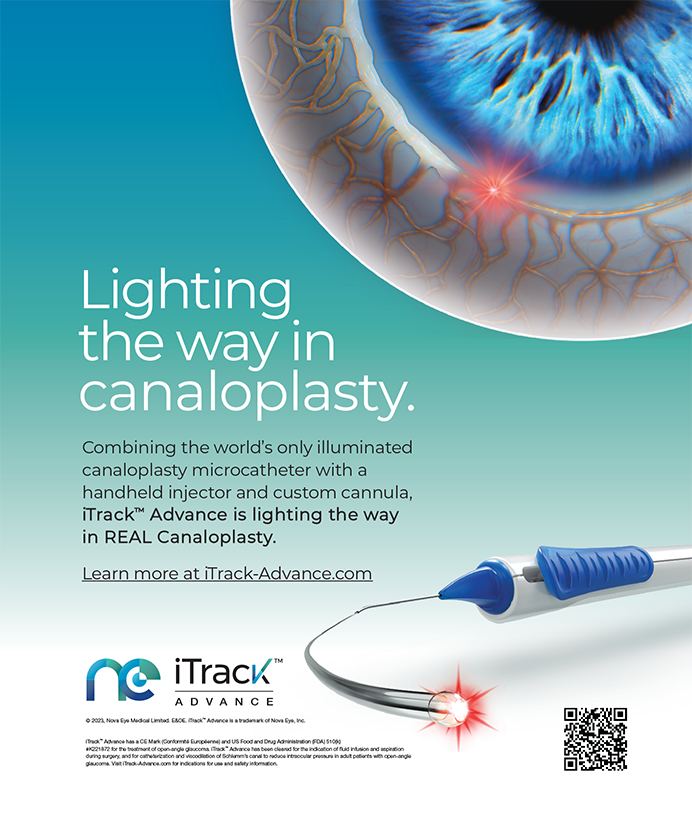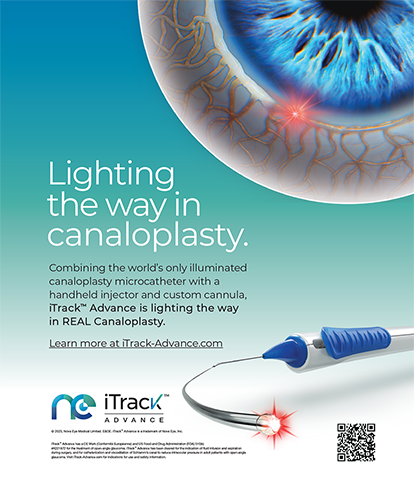The single-piece AcrySof Toric IOL (models T3, T4, and T5; Alcon Laboratories, Inc., Fort Worth, TX) has excellent rotational stability. In the 2005 FDA study of 244 cases, the average rotation 6 months after surgery was less than 4° from the IOL’s initial placement.1 Only five IOLs required reorientation, because they had rotated significantly within the capsular bag after surgery. Interestingly, in one case, the IOL rotated again after the secondary surgery, and it was exchanged for a nontoric single-piece monofocal lens. In the clinical trial, the AcrySof Toric IOL exhibited better rotational stability than did the STAAR Toric IOL (STAAR Surgical Company, Monrovia, CA) in its FDA clinical trial. In the 1998 study, the initial 10.8-mm model of that IOL (AA4203 TF) had an overall wrong orientation of greater than 20° postoperatively in 12% of cases.2 A longer model (11.2 mm; AA4203 TL) of this IOL was more stable. David Chang, MD, reported a surgical reorientation rate with the longer lens of 2.5%; in his series, 4% of IOLs were more than 15° off targeted alignment.3
Shortly after the single-piece AcrySof IOL’s introduction in 2000, an early photographic study demonstrated the rotational stability of the SA30AL, which has an overall length of 12.5 mm. The investigator identified only one IOL in 53 that had spontaneously rotated (14°) after surgery.4 Similarly, in a 2008 study, one of 100 AcrySof Toric IOLs was more than 15° off target.5 In a 2009 study, three of 263 (1.1%) were an average of 40° off axis. All of these lenses were reoriented surgically.6 Much like experience with the STAAR Toric IOL,7 the three affected eyes had greater than average axial lengths.
This article shares our experience with the AcrySof Toric IOL and our method of reorienting the lens in the rare instances when it rotates off axis.
OUR EXPERIENCE
We use temporal clear corneal incisions and DuoVisc (Alcon Laboratories, Inc.), and we remove as much viscoelastic as possible anterior and posterior to the IOL’s optic before final axial alignment of the AcrySof Toric IOL. We have observed 15° or more of postoperative misalignment with 13 of the 1,546 lenses we have implanted, an overall incidence of 0.8 % (JAD, 9/846 [1.0 %]; AJW, 4/700 [0.6%]). The amount of misalignment was substantial, ranging from 16° to 100°, with an average of 44° in one of our series (JAD) and from 15° to 55° with an average of 38° in the other (AJW). All of the lenses could be seen to have rotated clockwise, starting from a vertically oriented axis. This observation may demonstrate that gravity combined with ocular movement can propel a vertically oriented IOL off axis within several days of surgery such that the lens comes to rest in an oblique or horizontal position (Table 1).
We have used three surgical strategies for reorienting the IOL 2 to 8 weeks after the initial surgery in 12 of the 13 cases of misalignment. All three methods have successfully achieved good UCVA and generated no complications, except in two cases, when the IOLs again rotated 11° and 30° after the second surgery.
SURGICAL STRATEGIES
Background
We reoriented all of the IOLs in the OR and used topicalintracameral anesthesia. The CPT code used for surgery was 66825 repositioning IOL, secondary procedure, with the 78 modifier applicable for reoperations that occurred within the 90-day postoperative period.
Method No. 1
In two cases (Table 1), Dr. Davison made two paracentesis incisions and rotated the IOL with a Lester Hook (Katena Products, Inc., Denville, NJ). As the anterior chamber became shallow, he injected BSS through one of the paracentesis incisions via a 30-gauge cannula on a 5-mL syringe. The steps were serial (ie, hook rotation, BSS, hook rotation, etc.) until the lens was loose enough to rotate while the cannula continuously delivered BSS (Figures 1 and 2). This was probably the most difficult of the three techniques to accomplish. The technique was employed owing to concern that the introduction of an ophthalmic viscosurgical device (OVD) might contribute to recurrent postoperative rotation of the IOL. This technique is similar to one described by Dr. Chang.6
Method No. 2
In two cases (Table 1), Dr. Weinstein created two paracenteses and enlarged the left incision to accommodate a Lewicky Infusion Cannula (BD, Franklin Lakes, NJ). With the constant infusion of BSS, he rotated the IOLs into the correct orientation with a Lester Hook (Figure 3). This technique was easier than the alternating infusion-rotation method and retained the advantages of not opening the primary incision and not introducing an OVD.
Method No. 3
In eight cases (seven for Dr. Davison and one for Dr. Weinstein) (Table 1), we opened the original paracentesis and primary incisions, filled the anterior chamber in front of the IOL’s optic with ProVisc (Alcon Laboratories, Inc.), rotated the IOL with a Lester Hook, removed the OVD with the I/A tip, and achieved the IOL’s final orientation with a 30-gauge cannula while maintaining the anterior chamber with BSS.
This was the easiest of the three surgical methods, but it had the disadvantages of opening the primary incision and requiring an OVD. We used a cohesive OVD to ensure its complete evacuation at the end of the case. The IOLs remained aligned in six cases, with the patients achieving their anticipated visual recovery. Two of the eight (25%) IOLs, however, rotated 11° (JAD) and 30° (AJW) after reorientation with this method. The patients were satisfied, however, so no additional surgery was performed.
SUSCEPTIBLE EYES
In our series, low-, low-intermediate°, intermediate°, high-intermediate–, and high-powered IOLs had respective misalignment rates of approximately 3.4%, 1.4%, 0.5%, 0%, and 0% (Figure 4). Grouped another way, 10 of 13 (77%) cases of misalignment occurred with IOL powers of 6.00 to 15.50 D, three of 13 (23%) cases with powers from 16.00 to 20.50 D, and none with powers between 21.00 and 30.00 D. We have concluded that, even with an overall length of 13.0 mm and relatively thick (0.4 mm), bulky haptic architecture, insufficient contact between the IOL and the tissue of large capsules can fail to inhibit spontaneous early postoperative rotation of the AcrySof Toric IOL.
TIMING OF REORIENTATION
The timing and method of reorientation surgery may be important in reducing the chance of recurrent postoperative spontaneous rotation, but the optimal parameters are unknown due to the problem’s low incidence. In our experience, patients can usually tolerate waiting 2 to 3 weeks after the original surgery before secondary intervention, so that latency seems reasonable. Waiting longer might allow the capsular bag to contract and make its contact with the haptics more likely, but this possible advantage must be weighed against the patient’s wishes and the difficulties that might be encountered when dislodging the distal haptics from the capsular bag after fibrosis had begun.
CONCLUSION
We continue to remove as much viscoelastic as possible from in front of and behind the optic in all toric IOL cases but especially in longer eyes. There may be an increased risk of recurrent misalignment if an OVD is used during reorientation surgery. A new instrument, the Donnenfeld Irrigating Hook (Accutome, Inc., Malvern, PA), should make reorientation easier and obviate the need for an OVD. We speculate that it may be helpful to create a slightly extended incisional shelf in myopic eyes in order to avoid overinflation of the globe and capsular bag when we seal the incisions at the conclusion of surgery.
Despite rare instances of postoperative axial misalignment, we continue to be enthusiastic users of AcrySof Toric IOLs, because they provide great overall visual improvement to our patients with keratometric astigmatism. We advise patients that there is an approximately 1% risk of misalignment overall and up to a 3% risk in the very nearsighted. We explain that reorientation surgery is sometimes needed to provide optimal results.
James A. Davison, MD, is board chairman of the Wolfe Eye Clinic in Marshalltown, Iowa. He is a paid consultant to Alcon Laboratories, Inc. Dr. Davison may be reached at (641) 754-6200; jdavison@wolfeclinic.com.
Art J. Weinstein, MD, is chairman of the board at Eye Associates of New Mexico in Albuquerque. He acknowledged no financial interest in the products or companies mentioned herein. Dr. Weinstein may be reached at (505) 888-5757.
- Alcon AcrySof Toric FDA Study 2005.http://www.fda.gov/MedicalDevices/ProductsandMedicalProcedures/ DeviceApprovalsandClearances/Recently-ApprovedDevices/ucm078462.htm.Accessed November 2009.
- STAAR Plate Haptic FDA 1998 Study.http://www.accessdata.fda.gov/scripts/cdrh/cfdocs/cfPMA/pma.cfm?id=2828. Accessed November 2009.
- Chang DF.Early rotational stability of the longer STAAR toric intraocular lens:fifty consecutive cases.J Cataract Refract Surg.2003;29:935-940.
- Davison JA.Clinical performance of Alcon SA30AL and SA60AT single-piece acrylic intraocular lenses.J Cataract Refract Surg.2002;28:1112-1123.
- Chang DF.Comparative rotational stability of single-piece open-loop acrylic and plate-haptic silicone toric intraocular lenses.J Cataract Refract Surg.2008;34:1842-1847.
- Chang DF.Repositioning technique and rate for toric intraocular lenses.[letter].J Cataract Refract Surg.2009;35:1315-1316.
- Ruhswurm I,Scholz U,Zehetmayer M,et al.Astigmat


